Can a cube that does not last for any time at all, have a real existence?
- The Time Traveler, H.G. Wells
- The Time Traveler, H.G. Wells
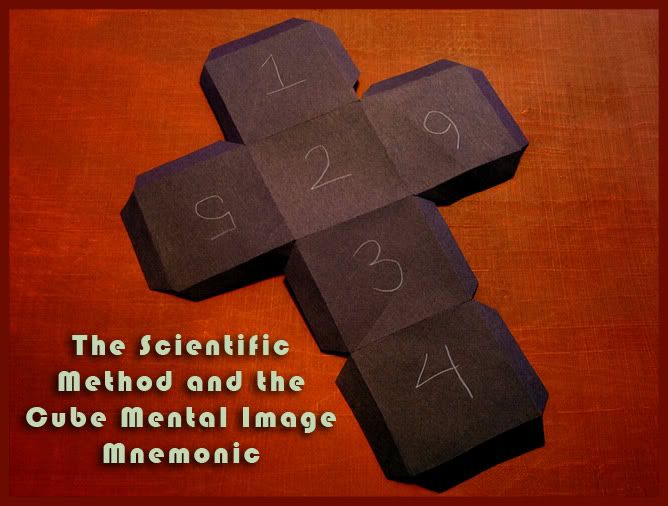
Learning requires memorization. While technology may reduce the need for the certain kinds of memorizations, problem solvers will always require a certain amount of well rehearsed information.
“Mnemonics” are devices or strategies which aid in memorization. Among the most commonly used mnemonics are acronyms, which use the first letter of each item in a list to form a key word. A common acrostic is ROY G BIV which helps students remember the colors of a rainbow.
A superior memory strategy is the imagery mnemonic. Ancient storytellers pioneered this way of recalling information by placing items within a mental snapshot of a scene. A mental image, especially one that involves a spatial relationship, is a useful map on which to draw memories. While acrostics are commonly taught in American schools, there are too few visual strategies taught.
A block is a shape synonymous with construction, from nursery room toys painted with the A-B-C’s, to bricks that are used in our buildings. These objects help build mental objects as well. This form carries many practical benefits besides its familiarity. A cube is a block composed of six planes; each plane has an “interior” side and an exterior side. By mapping a concept onto a 6 itemed list, the structure of a hollow cube can be used to create an image mnemonic.
The number six is a key characteristic of this mnemonic. The human mind can only retain 5-7 items in their short term memory. The six slots of the cube model mirror a threshold of a learner’s brain. The idea is best understood using a concrete example.
A building block of another kind is the scientific method. The scientific method is a set of principles and procedures for the systematic pursuit of knowledge. This involves recognition and formulation of a problem, the collection of data through observation and experiment, and the formulation and testing of hypotheses. Primary school teachers often simplify this definition by providing this one instead:
* Ask a Question
* Do Background Research
* Construct a Hypothesis
* Test Your Hypothesis by Doing an Experiment
* Analyze Your Data and Draw a Conclusion
* Communicate Your Results
Conveniently, this crucial concept fits neatly into the cube mnemonic. Each element of the definition can be mentally mapped onto an exterior side of the cube. This can be done in a practical way by drawing a cube pattern on a piece of paper, and writing the different items onto the sides of the cube.
A user can help create their mental model by physically constructing a cube with their own hands. By manipulating their physical example they are rehearsing their model of the cube mnemonic. With practice, the user will be able to visualize both the dimensions of the cube in their mind and the concept associated with each side.
There are advantages to the cube besides the six slots for information- the inherent properties of a cube allow for multiple ways of diagramming a cube in an “exploded” format. There are three main patterns or templates for constructing a cube out of a plane (in this case a piece of paper) these includes a “T”, a “Cross”, and a “Zig Zag”.
These templates can be seen below:
These different ways of visualizing organizing the same six nodes can reinforce different connections depending upon the placement of the same information in different contexts. In complement to the way the English language is read the “T” formation places the six items in a list reading from left to right, then up and down. In this case the user diagrams the information like this:
(Ask a question) (Do Background Research) (Construct a Hypothesis)
(Test your Hypothesis)
(Analyze Your Data and Draw Your Conclusion)
(Communicate Your Results)
(Test your Hypothesis)
(Analyze Your Data and Draw Your Conclusion)
(Communicate Your Results)
In this diagram, the branch of the “T” is special from the rest of the nodes; they are read first and they are read in a horizontal sequence. A student might draw these connections: the branch nodes are completed before the physical manipulation is begun, the branch nodes contain most humanistic steps, or that the remaining nodes are expected to be verifiable.
Another connection that a student might make is that node; “Analyze Your Data and Draw a Conclusion” could be written as two nodes instead just one. This is an important issue because it causes a student to reflect on the meaning of both the mnemonic and the concept. The user should realize that they are both abstract models which are not laws. Scientists and educators also list steps to a scientific method like this:
1. Define the question
2. Gather information and resources (Observe)
3. Form hypothesis
4. Perform experiment and collect data
5. Analyze data
6. Interpret data and draw conclusions that serve as a starting point for new hypothesis
7. Publish results
8. Retest (frequently done by other scientists)
This definition can be more helpful or less helpful depending upon the user’s goals, but steps seven and eight can be considered understood steps in previous six step model. Both definitions adequately describe the concept and neither the six step nor the eight step definitions are more standard.
To illustrate the flexibility of both concepts, consider the elements of scientific writing:
- Introduction: Explain why you decided to conduct your research.
- Materials: Explain what you used to perform your experiment.
- Methods: Describe the way you performed your experiment.
- Results: Present the data you collected in your experiment.
- Analysis: Interpret the meaning of the data you collected.
- Conclusion: Discuss how the questions asked in your hypothesis were answered.
Scientific writing is utilized by both published scientists who are held to a rigorous standard and individuals who use it as a guide for various practices. The scientific method is alternatively listed in such a way that defines “Materials” and “Methods” as a single item. Similarly, the “Conclusion” item is sometimes called, “Discussion.” In this alternative definition, the acronym, “I’M RAD” can be used. The acronym mnemonic and the image mnemonic are not exclusive; they are used well together:
In this orientation of the cube image mnemonic the “Materials” and “Methods” nodes flank the “Results” node. In this way, the exploded cube is read from top to bottom, while also reading from the outside inward. This reading protocol is less standardized, but it conveys a more subtle relationship. Unlike a linear flow chart, this model suggests that “Materials” and “Methods” work in concert, they are considered simultaneously.
The practical usage of the scientific method and scientific writing are almost always interconnected. The 19th Century definition of the scientific method equally encapsulates our common definition of the scientific method which is taught in primary schools and it also covers the itemized definition of scientific writing. In a sense these two lists define two sides of the same coin. In a similar manner, the interior and exterior sides of the cube mnemonic can be mapped with each opposing concept. By comparing the information mapped on each side of the diagram plane, a student might draw these connections: The “introduction” step in scientific writing equates to the parallel item of “Asking a Question.”
So far this investigation has discussed the cube mnemonic as an exploded plane which consists of a mirrored two-dimensional surface. The constructed or “finished” cube is also an important configuration of the cube image mnemonic. Once again, the mental model is established by first constructing a physical object. This practical cube is assembled out of a piece of paper. It begins with a piece of paper inscribed with one of the three cube templates and it is finished when each of the node planes are erected at a perpendicular angle to their adjacent side. This can be accomplished by having a student connect cut out the template with scissors and connect the nodes with tape.
The goal of fabricating a physical example is to pair a spatial relationship to the individual nodes on the cube diagram. Once constructed, the object should be rotated in the user’s hands so that a single side of the cube is facing the eyes of the user at a perpendicular angle. Using the example diagram below, the node corresponding to the cube side, “Ask a Question” should be made visible to the user.
(Ask a question)
(Analyze and Draw Your Conclusion) (Do Background Research) (Communicate Results)
(Construct a hypothesis)
(Test your Hypothesis)
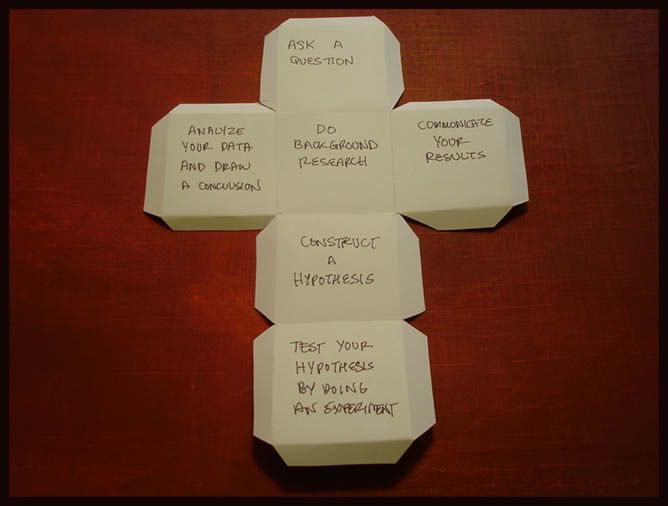
(Analyze and Draw Your Conclusion) (Do Background Research) (Communicate Results)
(Construct a hypothesis)
(Test your Hypothesis)

Next, the user should rotate the entire cube, one node away from their line of sight so that the node, “Do Background Research” is visible. With this same strategy, the user turns the cube away from their eyesight until they see, “Construct a Hypothesis,” then “Test Your Hypothesis by Doing an Experiment.” In the penultimate step, the user rotates the cube away from their eye line to their right; they will see, “Analyze Your Data and Draw a Conclusion.” Finally, the user must rotate their cube in either the right or left direction two nodes toward, “Communicate Your Results.”
This physical procedure demonstrates a spatial relationship which can be described this way in numerical order:
While using the cube mnemonic in its closed form, a student might make these connections: The final two steps in the scientific method have a special relationship to the rest of the nodes; they require that the experimenter make useful sense out of the previous work they have done in a way that others can interpret.
As mentioned above, the cube mnemonic is not restricted to diagramming the scientific method, and the scientific method is a complex concept open to many definitions. However, the above examples can be put to good use. The scientific method is an archetypal map for the cube mnemonic because it is a procedure which tells a comprehensive story. It also contains a means of connecting to other stories. The “understood” components of the scientific method, “Publish Results,” and “Retest,” allude to a self-renewing process. Whether an experimenter clarifies their findings or another experimenter verifies those findings the scientific method is a system designed to be reproduced. By remembering this symbolic example, the scientific method as a cube; the cube mnemonic can be applied to the memorization of other concepts.
Below is a demonstration of the a physical cube's manipulation:
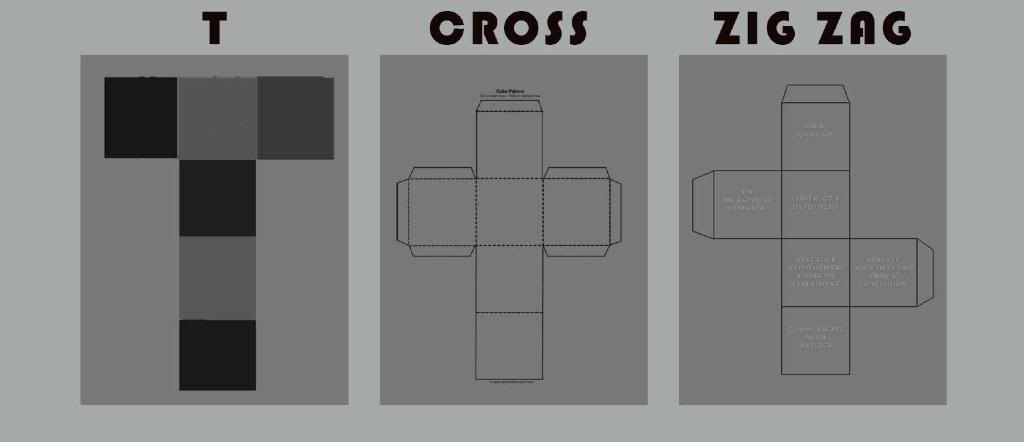
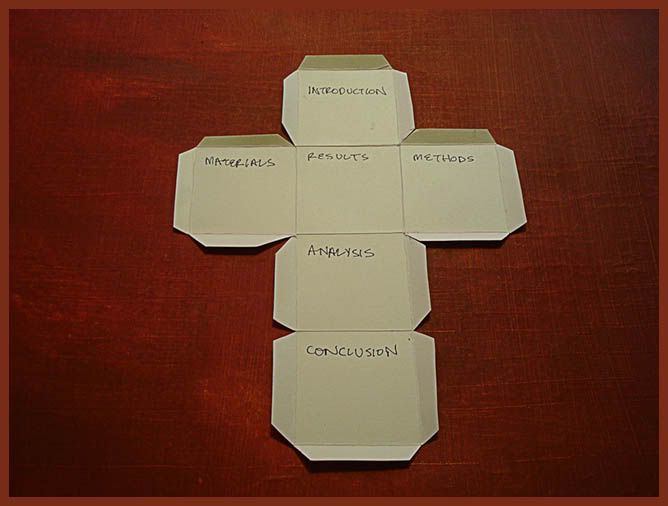
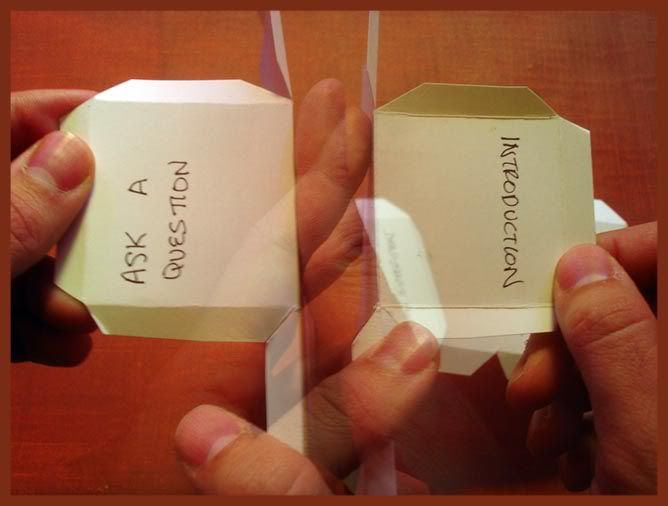
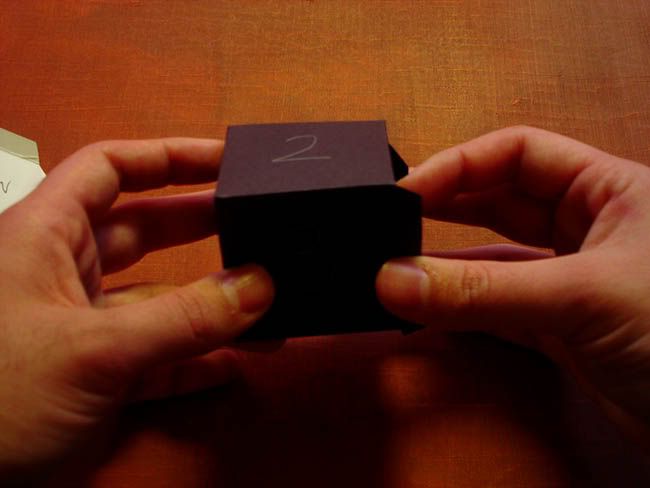
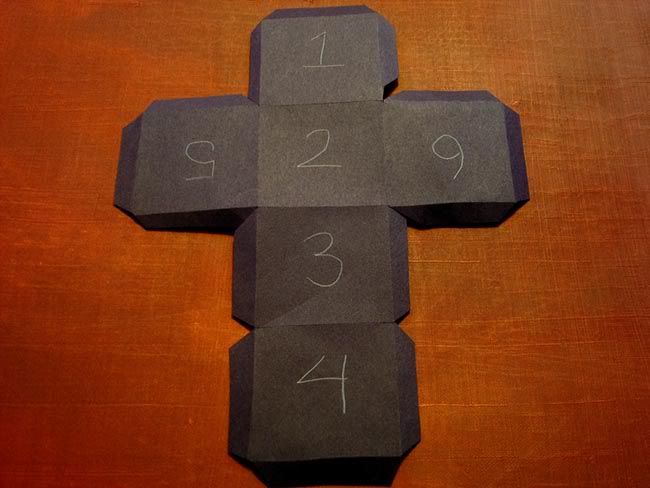

0 comments:
Post a Comment